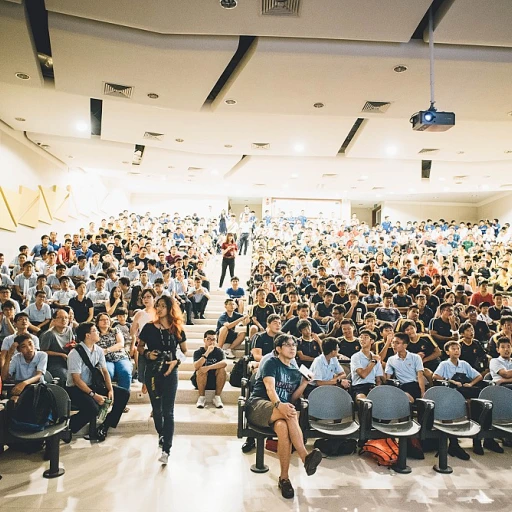
Understanding digital employee recruitment
The shift from traditional to digital recruiting
Digital employee recruitment is reshaping how organizations find and hire top talent. The days of relying solely on paper resumes, in-person interviews, and classified ads are fading. Today, technology is at the heart of the recruitment process, making it faster, more efficient, and often more effective. Digital recruiting uses a range of online tools and platforms to connect with job seekers, screen applicants, and manage the hiring process from start to finish.
What makes digital recruitment different?
Unlike traditional methods, digital recruitment leverages social media, job boards, and professional platforms like LinkedIn to reach a broader pool of candidates. This approach allows hiring managers to target both active and passive candidates, ensuring access to a wider range of qualified candidates. Video interviews, automated screening tools, and data-driven strategies help streamline the application process, saving time for both recruiters and applicants. The candidate experience is also enhanced, as digital tools make it easier for job seekers to apply, track their applications, and engage with potential employers.
- Broader reach: Social media and job boards connect organizations with top talent worldwide.
- Efficiency: Automated tools speed up the recruitment process and reduce manual tasks.
- Data-driven insights: Analytics help identify top candidates and improve recruiting efforts.
- Improved candidate experience: Digital platforms make the application process more transparent and user-friendly.
Why digital recruitment matters for CHROs
For chief human resources officers, embracing digital recruitment is not just about keeping up with trends. It is about building a strategy that attracts top digital talent, enhances the employer brand, and delivers a seamless experience for both candidates and hiring managers. The use of technology in talent acquisition allows CHROs to adapt quickly to changing market demands and stay competitive in the search for top candidates. As digital tools continue to evolve, understanding their impact on the hiring process is essential for anyone in a leadership HR role.
For a deeper dive into how technology is influencing HR strategies, you can explore the benefits of risk management tools in HR.
Key challenges for chief human resources officers
Adapting to a Rapidly Evolving Recruitment Landscape
Chief human resources officers (CHROs) face a complex set of challenges as digital recruiting transforms the hiring process. The shift to digital recruitment means that traditional methods are no longer enough to attract top talent. Today, CHROs must manage a recruitment process that is faster, more transparent, and highly competitive. The pressure to find qualified candidates quickly, while ensuring a positive candidate experience, is greater than ever.
Navigating Technology Overload
With so many digital tools and platforms available, from job boards to social media and video interviews, CHROs must decide which technologies best fit their organization’s talent acquisition strategy. The challenge is not just adopting new tools, but integrating them into a seamless process that supports both hiring managers and job seekers. Balancing automation with a human touch is key to maintaining a strong employer brand and engaging top candidates.
Ensuring Data Security and Compliance
As digital recruitment relies heavily on data, CHROs must ensure that applicant information is handled securely and in compliance with regulations. The use of AI and analytics in the application process raises questions about privacy, fairness, and transparency. Staying ahead of these concerns is crucial for building trust with candidates and protecting the organization’s reputation. For more on leveraging AI and compliance in HR, see how AI enhances integrated ISO audits.
Reaching Passive and Diverse Candidates
Digital recruiting opens up access to a wider pool of applicants, including passive candidates who may not be actively seeking a job. However, reaching these individuals requires a targeted strategy across platforms like LinkedIn and other social channels. CHROs must also ensure that their recruiting efforts promote diversity and inclusion, using technology to reduce bias and attract a broader range of talent.
Managing the Candidate Experience
In a digital-first environment, the candidate experience is shaped by every interaction, from the initial job posting to the final interview. CHROs must streamline the application process, provide timely feedback, and use digital tools to keep candidates engaged. A poor experience can deter top talent and damage the employer brand, making it essential to prioritize transparency and communication throughout the hiring process.
Essential digital tools and platforms
Must-Have Digital Tools for Modern Recruitment
Today’s chief human resources officers (CHROs) rely on a suite of digital tools to streamline the recruitment process and attract top talent. The right technology can make a significant difference in finding qualified candidates efficiently, improving the candidate experience, and supporting hiring managers in their decision-making. Here’s a closer look at the essential digital recruiting tools and platforms shaping the hiring process:
- Applicant Tracking Systems (ATS): These platforms help manage the entire recruitment process, from posting jobs to tracking applicants and scheduling interviews. They centralize candidate data, making it easier to identify top candidates and reduce time-to-hire.
- Job Boards and Aggregators: Posting jobs on popular job boards increases visibility among job seekers. Aggregators pull listings from multiple sources, expanding the reach to a broader pool of applicants.
- Social Media Recruiting: Platforms like LinkedIn, Facebook, and Twitter have become vital for sourcing passive candidates and promoting the employer brand. Social media recruiting allows CHROs to engage with talent where they spend their time online.
- Video Interviewing Tools: Video interviews save time and resources, especially for remote or global recruitment. These tools also enhance the candidate experience by offering flexibility and convenience.
- AI-Powered Screening: Artificial intelligence can analyze resumes, match candidates to job requirements, and even assess soft skills. This technology helps identify qualified candidates faster and reduces bias in the hiring process.
- Talent Acquisition Platforms: Comprehensive platforms integrate multiple recruiting efforts, from sourcing to onboarding, providing a seamless experience for both hiring managers and applicants.
Improving Candidate Experience with Technology
Digital recruitment tools are not just about efficiency—they also enhance the candidate experience. Automated communication keeps candidates informed throughout the application process, while user-friendly interfaces make it easier for job seekers to apply. Personalization features help tailor interactions, making candidates feel valued and increasing the chances of attracting top talent.
Leveraging Data for Smarter Recruiting
Modern digital recruiting platforms offer analytics and reporting features that help CHROs refine their recruitment strategy. By tracking metrics like time-to-fill, source of hire, and candidate drop-off rates, HR leaders can identify bottlenecks and optimize their recruiting efforts. This data-driven approach is essential for staying competitive in the search for top digital talent.
Staying Ahead with Continuous Learning
The landscape of digital recruitment is always evolving. CHROs must stay informed about the latest tools, trends, and best practices to maintain an edge in talent acquisition. For more insights on the future of HR leadership and digital recruitment, explore this in-depth look at the SHRM Talent Conference.
Building a digital employer brand
Why Employer Brand Matters in the Digital Age
Today, the employer brand is more than just a buzzword. In a digital recruiting landscape, it is a critical asset that shapes how job seekers and top talent perceive your organization. A strong employer brand can make your company stand out on job boards, social media, and digital platforms like LinkedIn. It helps attract qualified candidates and keeps your recruitment process competitive, even when top candidates have multiple options.
Strategies to Strengthen Your Digital Employer Brand
- Leverage Social Media: Consistently share authentic stories, employee testimonials, and company culture highlights. This gives candidates a real sense of what it’s like to work at your organization and improves candidate experience.
- Optimize Your Careers Page: Ensure your application process is clear and mobile-friendly. Showcase your values, benefits, and growth opportunities to engage both active and passive candidates.
- Engage with Job Seekers: Respond to reviews on platforms like Glassdoor and Indeed. Addressing feedback shows transparency and builds trust with applicants.
- Use Video Interviews and Content: Video interviews and behind-the-scenes videos can humanize your brand and make the hiring process more personal for candidates.
Integrating Technology for a Consistent Brand Experience
Digital recruitment tools and platforms help maintain a consistent employer brand across all touchpoints. Automated communication, personalized messaging, and AI-driven recommendations ensure every candidate receives timely updates and relevant information. This not only streamlines the recruitment process but also enhances the overall candidate experience, making your company more appealing to top digital talent.
Measuring the Impact of Your Employer Brand
Tracking metrics such as application rates, candidate engagement, and time to hire can reveal how effective your employer brand strategy is. Regularly reviewing these insights allows hiring managers and talent acquisition teams to refine their approach, ensuring recruiting efforts remain aligned with organizational goals and continue to attract top talent in a competitive digital landscape.
Data-driven decision making in recruitment
Making Recruitment Smarter with Data
Data-driven decision making is reshaping the way chief human resources officers (CHROs) approach recruiting and talent acquisition. With digital recruiting tools and platforms, HR leaders can now analyze every step of the recruitment process, from sourcing candidates to the final hiring decision. This shift allows organizations to find top talent faster, reduce bias, and improve the overall candidate experience.
- Tracking Key Metrics: Modern recruitment technology enables CHROs to monitor important metrics like time-to-hire, cost-per-hire, and candidate quality. By examining these data points, hiring managers can identify bottlenecks in the hiring process and adjust their strategy to attract more qualified candidates.
- Enhancing Candidate Experience: Data from digital recruitment platforms helps HR teams understand where applicants drop off in the application process. This insight allows for targeted improvements, making it easier for job seekers to apply and increasing the chances of securing top candidates.
- Optimizing Sourcing Channels: With analytics, CHROs can see which job boards, social media platforms, and digital recruiting tools deliver the best results. This information supports smarter allocation of recruiting efforts and budget, ensuring the organization reaches both active and passive candidates.
- Predicting Hiring Success: By leveraging data from previous hires, HR leaders can identify patterns that predict which applicants are likely to become high performers. This predictive approach helps organizations focus on top digital talent and improve retention rates.
Integrating Data into Everyday HR Practice
For CHROs, embedding data-driven insights into daily recruiting activities is essential. This means using dashboards and reports to guide decisions, training hiring managers on interpreting analytics, and continuously refining the recruitment strategy. Video interviews, social media analytics, and candidate feedback tools all contribute valuable data that can be used to enhance the hiring process.
Ultimately, data-driven recruitment empowers HR leaders to make more informed choices, reduce time-to-hire, and build a stronger employer brand. As digital recruitment evolves, the ability to harness and interpret data will remain a key differentiator for organizations seeking top talent in a competitive job market.
Future trends in digital employee recruitment
Emerging Technologies Shaping Recruitment
The landscape of digital recruiting is evolving rapidly, with new technologies continuously reshaping how organizations find and hire top talent. Artificial intelligence (AI) and machine learning are now central to the recruitment process, helping hiring managers sift through large pools of applicants to identify qualified candidates more efficiently. These tools can automate repetitive tasks, such as screening resumes and scheduling interviews, saving valuable time and allowing HR leaders to focus on more strategic aspects of talent acquisition.
Personalization and Candidate Experience
As digital recruitment becomes more sophisticated, the focus on candidate experience is intensifying. Personalized communication, powered by data analytics, ensures that job seekers receive relevant information throughout the application process. Platforms like LinkedIn and specialized job boards are leveraging algorithms to match candidates with roles that fit their skills and interests, making it easier for both employers and applicants to find the right fit. This approach not only improves the experience for candidates but also increases the likelihood of attracting top candidates who align with the company’s culture and values.
Social Media and Employer Branding
Social media continues to play a pivotal role in digital recruiting strategies. Companies are using platforms such as LinkedIn, Twitter, and Instagram to showcase their employer brand and engage with both active and passive candidates. By sharing authentic stories and insights about the workplace, organizations can attract job seekers who resonate with their values. This trend is expected to grow, with more emphasis on creating engaging content that highlights the unique aspects of the employee experience.
Remote Hiring and Global Talent Pools
The shift to remote work has expanded the reach of digital recruitment, enabling organizations to tap into global talent pools. Video interviews and virtual assessment tools have become standard parts of the hiring process, allowing companies to evaluate candidates from anywhere in the world. This not only increases access to top digital talent but also introduces new challenges in ensuring a fair and consistent recruitment process across different regions and cultures.
Data-Driven Recruitment Strategies
Data-driven decision making is becoming a cornerstone of effective recruitment. By analyzing metrics such as time-to-hire, source of hire, and candidate drop-off rates, HR leaders can refine their recruiting efforts and optimize the application process. Predictive analytics are also being used to forecast future hiring needs and identify potential skills gaps, helping organizations stay ahead in the competition for top talent.
Continuous Learning and Adaptation
Finally, the future of digital recruitment will require chief human resources officers and their teams to stay agile and continuously update their skills. As new tools and platforms emerge, ongoing training will be essential to ensure that recruitment strategies remain effective and relevant. Embracing a mindset of continuous improvement will help organizations attract and retain the best candidates in an ever-changing digital landscape.












